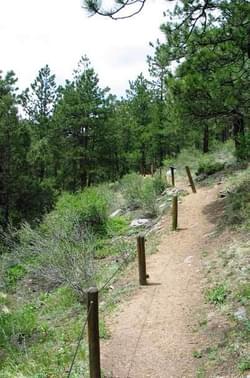




Braille trails and sensory gardens offer sustainable and accessible ways to safely experience the outdoors and provide opportunities to interact with nature.

Braille trails and sensory gardens offer sustainable and accessible ways to safely experience the outdoors and provide opportunities to interact with nature. Tactile additions such as Braille signs, guide ropes and path markers allow the visually impaired to enjoy trails and gardens without assistance, and accessible pathways remove barriers to mobility regularly experienced by those with disabilities.
A Braille Nature Trail is a nature trail with Braille informational signs and physical aides that allow the visually impaired to experience the trail unassisted. Braille trails usually include a guide rope for the visually impaired to hold and follow along the path with markers for Braille informational signs. Some trails have tactile walkways to provide direction, others have audio components such as guided audio tours or smartphone access, and many are wheelchair accessible.
A sensory garden is designed to provide tactile experiences through the use of specific plants in a specially designed layout to create opportunities and accommodations for the visually impaired and others with disabilities to enjoy the touch, sound and smells of the outdoors. Sensory gardens usually have Braille informational signs and aromatic plants to touch and smell, and can also have audio features, guide ropes or rails, raised garden beds, and tactile pathways for the visually impaired to utilize to walk along the paths unassisted. Many sensory gardens are also wheelchair accessible.
There is not much information on building or renovating a braille trail. As part of the American Trails Advancing Trails Webinar series, the Creating Accessible Trails with Universally Designed Interpretation webinar provides an overview of Mass Audubon’s All Persons Hiking Trails. The All Person Trails typically have boardwalks and bridges over or alongside wetlands, some navigational resources (such as rope guides or curbing for visually impaired visitors), wayside multisensory stops and displays, and trail materials in multiple formats including audio tours, braille signage and booklets, and tactile trail maps.
Here's a few locations where visually impaired visitors can enjoy a trail, and a few where technology allows a person to listen through a smartphone.
You can also locate state contacts on our Resources by State page.
American Hiking Society National Trails Day® Event Host Guide (2023)
posted Apr 16, 2024
This guide will provide you with the following resources and knowledge you need to plan and promote a successful event for National Trails Day®.
League of American Bicyclists National Bike Month Guide (2023)
posted Apr 16, 2024
May is National Bike Month, sponsored by the League of American Bicyclists, and celebrated in communities from coast to coast. This step-by-step guide will help you in creating a successful Bike Month event in your community, workplace, city or state.
Making Transportation Planning Applicable in Tribal Communities Research Study: Final Report
posted Dec 20, 2023
The Federal Highway Administration’s (FHWA) Office of Tribal Transportation (OTT) planning staff have observed two challenges in Tribal transportation planning: (1) that existing planning analysis tools do not always align with Tribal community context and needs and (2) it is not always clear what benefits planning provides to transportation project selection and delivery in Tribal communities.
posted Dec 20, 2023
This report and its appendices constitute a review of law, policy, and procedures, with recommendations for changes based on Tribal consultation and public comments.
6,832 views • posted 07/24/2018